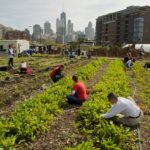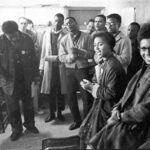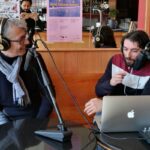New Rural Arts Seminar Report
Stephanie Sherman
New Rural Arts Seminar @ the Merz Barn, Elterwater, Cumbria, UK
July 25th 2014–In Cumbria, England, a four hour train-ride north of London, a group of 30-some-odd organizers, largely from rural UK, gathered by the Merz Barn on the Cylinders Estate for a one-day event entitled The New Rural Arts Seminar. Organized by community arts leaders Ian Hunter and Celia Larner, the Seminar was initiated primarily in response to an Arts Council England’s (ACE) Position Report issued the month prior, but it also seized upon a confluence of international visitors to connect artists and leaders redefining contemporary rural practice in the UK and beyond.
Hunter and Larner are long leading figures of the community arts movement in England, and for years they’ve organized projects, advocacy and research that contribute to social change, focused particularly on rural areas. In recent years Hunter and Larner have been purveyors, homesteaders, keepers, and curators of the Cylinder’s Estate, a lovely plot of land in the well-destined Lake District once a gun-manufacturing site that hosts a summer cottage and most exceptionally a barn that formerly served as a studio and installation site of the late dadaist artist Kurt Schwitters. After escape from Nazi Germany and political internment on the Isle of Man, Schwitters landed in North England’s Ambleside, painting portraits and landscapes for income, and with a grant from MoMA, spent his final days through 1947 working in the rented barn on the Cylinder’s Estate creating the Elterwater Merz Barn, the last in the series of four Merzbauten installations.[1]

The Estate property was later abandoned for some years, and in 1968 the artist Richard Hamilton rescued the decomposing Merzbau, removing the entire wall which contained Schwitter sculpture and permanently re-installing it in the Hatton Gallery in Newcastle. Hunter and Lerner purchased the property in 1998, and in the spirit of Schwitters have converted it into a seasonal venue for artists and students undertaking site-specific, conceptual and collaborative interpretations and investigations of the barn, grounds, and rural context. The fact that the barn no longer contains the actual project does not prevent it from being a destination of historical significance, drawing tourists and neighbors in the region and artists from the UK and beyond and attracting interest of British institutions such as the Tate invested in heritage and legacies of WWII on the arts in the period. Instead of featuring works, the Merz Barn project activates the legacy of Schwitters as creative figure and political subject. This history predicates a platform for exploring contemporary forms for rural art practice and production, and provides the magnetism for a homely gathering space for artists, students, rural communities, tourists, and neighbors. The Merz Barn has been a passion of Hunter and Larner’s for years, and they have extensive dreams for its future, but to truly become a destination and center for production and pedagogy, the barn and property houses require substantial maintenance and restoration, a blessing and burden for its visionaries.
The Merz Barn project is part of a Littoral Arts Trust, a creative consultancy of Hunter and Learner which focuses on art and culture in rural contexts. Littoral “promotes new creative strategies, artistic interventions and cultural partnerships in response to issues about social, cultural and environmental change.”[2] Hunter and Larner define this work as a “deep practice” with an “immersive aesthetic” which mobilizes “art and the policy sphere.” They see these terms as offering alternative terminology to concepts such as public art, relational aesthetics and community art, which have been co-opted by institutions beyond the constituencies they serve. Littoral’s projects and research aim to promote cultural equity for marginalised rural communities and other underrepresented groups in society through a range of curatorial and organisational strategies including conferences, exhibitions, artists’ commissions, publications, and research. Littoral sees art as a strategy for addressing the real-needs of rural communities, collaborating with community groups, trade unions, health care agencies, culturally diverse farmers, artists and rural organisations. Some broadly known Littoral initiatives include Rural Shift–an advocacy effort championing the creative work of artists in response to Foot and Mouth disease in the 1980s, New Fields–which develops frameworks for art and agricultural developments, and Culture after Conflict–which considers art and nationhood in the wake of violent conflict. After decades of projects, Littoral has developed a deep perspective on art and culture as tools for social equity, a vast network of global practitioners and makers, and advanced know-how in the role of art and creativity in rural settings.
Between 2002 and 2013, Arts Council England commissioned the Littoral Arts Trust to undertake a series of regional and national studies that would develop new thinking around the future of arts and cultural policy and rural issues. The main outcome of this work was a series of research reports that recognized (1) the radical complexity and systemic nature of the changes (economic, social, cultural, and environmental) taking place within rural communities and the agriculture sector, and called for (2) the urgent need for some kind of a coordinated national cultural strategic response on the part of the arts and cultural sector–a Rural Cultural Strategy (RCS). These findings were published by Littoral in the New Rural Arts Report (2004), outlined in more detail in the Creative Rural Communities Report (March 2010), and later confirmed in the follow-up independent Holden Report (March 2012).[3] They were also synthesized in the ACE[4]. While ACE has long supported Littoral’s research, they’ve recently repeatedly denied Merz Barn funding as part of austerity cuts in arts spending, making it difficult for Larner and Hunter to activate this knowledge or run any programming at the site. Because ACE’s allocations happen every three years and in a sweeping all-or-nothing fashion (compared to the US system, ACE grants are quite sizable and supportive), ACE funding often makes or breaks arts organizations, since there are so few other sources of support and little private philanthropy. Hunter and Larner are smart and scrappy, and so they’ve found ways to keep their operation going through small grants, donations and art auctions. They’ve often felt that contemporary, socially-active work specific to rural issues and community practice has been relatively invisible to ACE panels, which they attribute to the Council’s longstanding commitment to traditional arts forms and institutions and predispositions about contemporary art practice defined by urban settings. The current lack of financial support is increasingly unsustainable, as Hunter and Learner expend energy beyond their years and means to keep growing and maintaining the estate.
In June 2014, ACE published a position report addressing and updating their rural arts policy.[5] This report triggered a strong response from Littoral and other independent rural arts groups and practitioners in England. Many of the smaller arts agencies and individual artists felt that the ACE Position Report reflected a lack of understanding of the conditions of rural practice, disregarded the extensive research that they themselves had commissioned, and ignored the new aesthetic, political and critical challenges facing rural communities. These groups were also frustrated by ACE’s repeated mandate and rhetoric to public service, and the perceived consistent lack of support for constituencies of artists and rural communities on the ground.
The New Rural Arts Seminar thus provided a useful opportunity for political advocacy and alliance building in response to this ACE position report. With 30-some-odd artists, curators, and organizers from Northern England and across the world under an open air tent, the gathering was the first of its kind according to the memories of those in attendance. The agenda for the day set the following topics for discussion: 1) Consider the future of arts and rural communities in an effort to respond to the arts council’s position via academic perspective, followed by an open discussion forum and 2) Consider what is New about Rural Arts through a series of possibilities for future developments including (a) a proposal to set up a new rural arts practitioner and researchers network for England, (b) to set a New Rural Arts pedagogy and academic research programme, (c) to consider a proposal put forward by the RCF for a Rural Biennale[6] and, (d) to consider a proposal from the League of Culture to host a rural cultural (new rural arts) summit conference in London in 2015.[7] The ACE report thus offered a catalyst to assess the concept of the “new” rural arts from the vantage of its practitioners, evaluate funding and support conditions, and discuss new ventures to strengthen the network and build allies.

This was the first time in over a decade that any such coordinated forum of the contemporary crop of rural arts organizers had taken place. UK nationals included artists, curators, and organizers from the rural counties through to London. Participants included Allenhead Arts, Beacon Arts, Grizedale Arts, Dumfries and Galloway, North Light Arts, and Visual Arts Southwest. International guests included Esther Anatolitis from the Regional Arts Victoria Australia, Fernando Garcia-Dory of Inland, an arts, agriculture, and country initiative Campo Adentro in Spain, and myself who spoke on behalf of the US-based FIELD Journal as well as the Common Field initiative. The seminar was possible in part thanks to the collaborative work of Vicky Prior, an ambitious and spritely political arts organizer, who had partnered with Hunter to initiate the gathering on behalf of the League of Culture–an advocacy initiative she’s founded to represent creative practitioners and organizers in the political sphere. Also in attendance was two ACE delegates, sent to the meeting to represent the ACE perspective and hear the community’s concerns. Hunter was a buoyant host, facilitator, and leader, offering incessant introductions and instigating creative banter between receptive guests, and Larner the quiet mastermind, who orchestrated the entire event behind the scenes–from concept to sustenance.
Two ACE representatives, David Gaffney and Marla Percival, opened the seminar by reiterating the ACE position report’s conclusion that rural communities are already benefiting equally from ACE support, with no need for separate funding categories or specific allocations set aside for rural communities. Gaffney and Percival highlighted ACE’s work in addressing rural issues through collaborations with rural agencies and iterated statistics that show attention to rural issues and participation in ACE funded projects by rural communities. The June 2014 report indicates more specifically that ACE funds serve people in areas urban (82.4%) and rural (17.6%), proportionate to population, and notes that data shows that arts engagement and library attendance is higher in rural areas, but only by 2% in each case. The report discloses the failings of its current survey data: “because ACE records grant awards by the location of the receiving organisation and not by the location deriving benefit, the Arts Council cannot give a full picture of the geographic extent and range of benefit. This is an issue that we are actively seeking to rectify.”[8] The report concludes that since rural communities are already receiving fair benefit, there is no need for separate, additional, or specific strategic allocations to rural issues, and iterates that ACE expects to “see rural communities benefiting appropriately from the totality of our support.” ACE argues that it intends to continue to identify ways that it can be of service to rural initiatives, and sites work with Defra (Department for Environment, Food & Rural Affairs) as well as local trusts and enterprises as part of their strategy. The report then notes plans for future Arts Council funding rounds, and cites no plan for any policy or strategic change on the rural issue until further notice.
The first respondent was Wallace Heim, a scholar focusing on rural arts and ecology. Heim brought forward two major contradictions in the ACE statement and report. Firstly, Heim noted that while the report recognises that rural communities have particular needs and characteristics – including sparsity, deprivation and access, aging populations, economies of tourism and sports, and a proven capacity of arts impact in these sectors–ACE refuses the need for a specific strategy or investment program focused on these different needs and characteristics. When rural projects compete for funding with projects in London that have greater visibility, star-power, and resonance with ACE panels, any focus they have on these rural issues will be less identifiable to urban-oriented panels. Secondly, ACE pledges to take these factors into account, but the report’s insistence on collaborations with bureaucracies suggests a world of remove between ACE ideas and realities for rural artists, practitioners, and communities on the ground. While ACE insists that it will continue work with rural entities, the report offers no plan for actual engagement with the constituencies who its services intend to directly support. This is complexified even further by disproportionate support for the ACE coming from rural communities, since the Heritage Lottery Fund, a category of ACE grants, is funded by lottery tickets more popular in rural communities.
Heim’s most poignant insight is that the biggest challenge for ACE and the group sitting before her is an adequate working definition of rural arts. Heim notes that the ACE document comments on rural communities, without really defining what, who, or where the rural means: “The rural is described as a dynamic and vital part of the artistic, social, economic and corporate life of the country. The rural is described by disadvantage, by difficulty of access to urban culture, or as newly liberated by digital technologies, or as the place where people go for recreation in the tourism economies. Oddly – it’s not described by ethnicity, gender, class and migration. Or by the environmental or ecological conditions which are increasingly relevant to cultural production.” Without a new working definition for the rural, Heim reflects, its very difficult to advocate for the rural or define it as a category or kind. Heim also points out that the very definition of the rural is rapidly changing. The ACE statistics do not acknowledge the mobility of artists and the public alike, who move flexibly through urban and rural environments as centers for home and work, labor and leisure, publicity and retreat. Without more extended information and a real understanding of these flows, it’s almost impossible to assess practitioner needs, community demands, and “fair” distribution of funds. Heim insists that more evidence on the dynamics of art production, reception, exhibition, and involvement is required to understand the rural as a whole.
Hunter reframed the problem at hand, in the jovially evocative and provocative way he tends to do. Since ACE has argued that no separate funding categories or allocations are necessary, the question remains as to whether ACE will give the rural the respect and perspective it deserves. Hunter asks with a great dose of skepticism: will ACE have the capacity to see what is required to serve rural communities? Will it recognize art of quality for these communities when in competition with the overwhelming plurality of urban proposals? Will it manage to engage these differences in ways that accommodate its own ignorance and disposition towards urban forms of art? Both Hunter and Heim articulate the need for ACE to become less defensive about dealing with some of the more radical manifestations of rural art production and its effects, and most importantly, to try and grapple with the different constituencies of artists and publics served in rural areas. In later conversation, Hunter expresses concern over ACE’s lack of connection with contemporary critical practice related to new post-agricultural rural agendas and aesthetics. Hunter sees ACE’s report as a diversionary tactic to avoid dealing with their core constituencies and their own lack of information about rural practices. Hunter argues that ACE could easily be doing more to support all the artists (urban and rural) who are currently engaging with the complexities of the rural communities and cultures that the Arts Council are responsible for supporting.
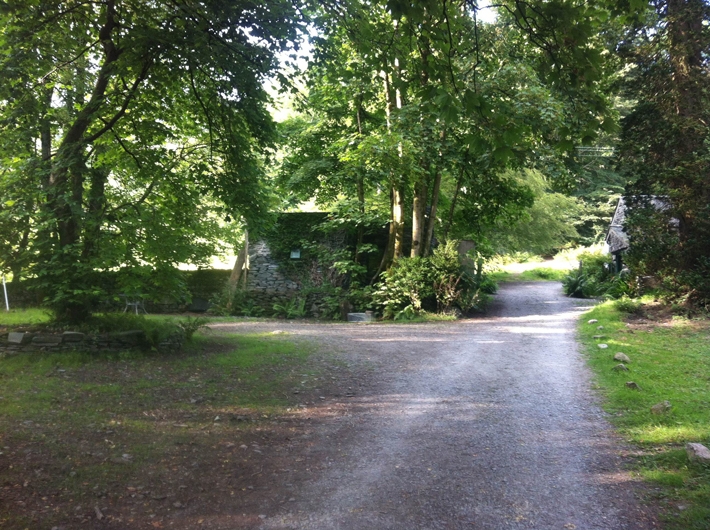
In the last five years (2009 – 2014), ACE has been the subject of a Government-sponsored inquiry for its lack of proper responsiveness to the constituent issues and its regular refusal of support for innovative rural cultural practices and other intellectual and creative developments emerging in the rural sector. The Arts Council’s deficiencies in this context were highlighted again recently in several national reports, including a high level UK Government Parliamentary Inquiry (November 2014) and the ‘Rebalancing our Cultural Capital’ and ‘A Hard Place’ reports (2013/15) issued by the GPS group–an independent UK-based collective of arts and cultural policy researchers and academics. GPS criticised the Arts Council for its failure to act responsively to its constituencies and changes in the cultural landscape–instead receding to ideologies about heritage, legacy, and tradition instead of responding to data, constituency response, or organizational need. The GPS report concludes that “Arts Council England has continued to demonstrate a systemic inability to reform itself without external intervention. The forces of custom, practice and vested interest [are] just too strong.”[9]
Heim’s and Hunter’s request for a definition of the “new” rural elicited a few crucial points from the group at large. 1) The rural cannot be defined only in antitheses to the urban or metropolitan, but it must come to its own terms. 2) The term rural often incorporates assumptions generated by city people about country people–presumptions of simplicity, the delivery of the haves to the have-nots in terms of community arts, senses of slow progress and lack of development–but the alternative definition of the rural is unclear. 3) The rural must be understood in dynamic relation to the suburban and urban, regarding density and access, diversity and difference. 4) Since the rural communities disproportionately support the Lottery fund in the first place by purchasing more tickets, the arts heritage allocation should be higher for rural communities, s. 5) Rural art can be about location or home situated out of proximity, but this idea is increasingly challenged by artists who work in the city and retreat in the country, or create in the country and then show in the city, as well as by tourists, visitors, participants, where life and leisure offer a seamless permeability between these zones. 6) Rural art is best seen not as a genre of art, but as a context for addressing a set of issues more sensitive or embedded in the rural context, including, craft, agriculture, ecology, environment, or are specific to social problems in rural areas, such as Foot and Mouth. 7) Rural and folk art strategies–such as festivals and gatherings, simply don’t fit into the fine art criteria that ACES uses to judge artistic merit 8) The highly problematic British romanticization of the rural as an idyllic pastime, as exemplified in the recent Tate Britain exhibition, turns the countryside into a place about a nostalgic image of itself without social challenges or real concerns. 9) The rural is a configuration of social questions, a place contending with problems of immigration, environment, transport and access to cultural and educational opportunities. 10) Art, in the context of the rural, is a real strategy for negotiating how we live. The “new” rural arts might be understood as such. The “new” rural needs to be championed not by an aesthetic but social questions–considerations of how gender, class, ethnicity, and equity are shaped outside the city, how art is a tool for responding and invigorating social connection and debate around rural issues, and how art participates in an ecological model reflected and demonstrated in rural life itself.
The conversation evolved from positions and conclusions on the question of rural definition to ideas about formal hurdles to arts production that prevent meaningful change for communities. Rick Faulkner of Chrysalis Arts noted the problem of laborious outcome and economic-based measurement tools, which are deterrents for getting support into the hands of the practitioners and constituencies who need it. He recalled a simple grant scheme that unlike the laborious and extensive council applications asked for minimal administrative work and delivered broad support for community projects. Other attendees complained about the time consuming nature of project evaluations, while some members of the group defended them as outlets for reflection and response. The group concluded the problem of evaluation as a terminological one, mirroring the real problem in a psychology of assessment rather than learning. In sum, the group sought a balance of quantification and qualification in the funding process.
Lunch provisions supplied an informal opportunity to engage conversation over egg, potato, and tomato basil salads, breads and butter, cheeses, and stewed vegetables. A basket full of mugs provided service for copious rounds of tea, and juice was poured to deliver strength. I struck up a conversation with Danny Callagham, who spoke about his work with cultural trusts, where he engages workers and citizens around archived objects of the industrial revolution. We discussed art as a mode for learning, overcoming strangeness, for understanding the ways the arts transforms and extends industrial memories into cultural stories. In a flurry of post-lunch introductions, Hunter invited me into conversation with a man in a proper country hat whose name I never caught. He expressed that for him the lack of a category for the rural was not such a big deal, but getting recognition for the rural in the council was certainly important. Eventually I got round to asking him how he became involved in all of this. “I was sent to work in a factory and then I ran away and joined the circus. That circus led me straight to the arts.”
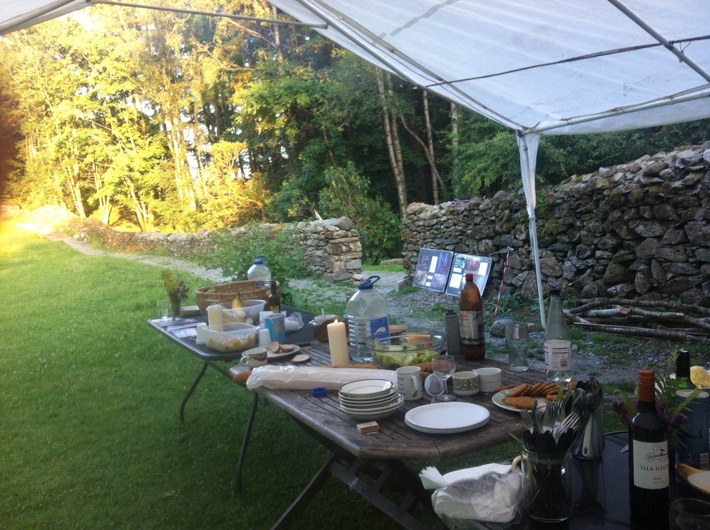
Gathering indoors after lunch, Sue Gill and John Fox opened an artist talk by celebrating Schwitter’s commitment to making art from anything, from rubbish to a single pencil, and his wild spirit. Gill and Fox are producers of a 38-year theater troupe–Welfare State International–which has recently produced interventions that blend festival, performance, and installation in boat vessels and cemeteries, as well as authors of Dead Good Guides. Their presentation invoked a long history of community practice, sensitive to site, politics, and place, incessantly cultivating meaning from point to point. Ian then called upon three participants to sit on a panel in the front, offer a quick present their work, and provide a response to the idea of a rural biennale. Each panelist started their introduction by insisting that they hadn’t time to prepare, gave brief presentations of their projects and expressed their distaste for the idea of a rural biennale. Jon Plowman of Beacon Arts spoke of the unique nature of the rural curating, where lots of space and time between works allows for an unparalleled reflection and processing time. Janet Ross of VARC (Visual Arts in Rural Communities) discussed the importance of outsider artists and community insiders coming together to discover stories in new ways during year-long site-specific residencies. Documentary photographer Walter Lewis reflected on how his project on farmers used visual culture techniques to facilitate conversations and tell stories of and in a changing landscape.
While the premise of a Rural Biennale was met with vehemence, with alternative models receiving much more interest. The Cumbria Biennale printed artworks on 25,000 town parking tickets, distributing works through a highly accessible public medium. Artist Jill Rock proudly and passionately discussed the London Biennale, which invited artists across the city to choreograph their own events, was conceived and operated from a pub, with no money ever changing hands for the robust site-specific program. Esther Anatolitis of Regional Arts Australia spoke of her involvement with a series of Australian Biennales that attempted to revamp the model by supporting local artists and drawing outsiders into unusual places. The consensus was that if a Rural Biennale were to exist, it would need to look so unlike the traditional biennale model of big money and outsider investment that it might not even be termed a Biennale in the end.
The group migrated outside for the final stretch of the day’s dialogue. The new rural, all agreed, is a context for engaging the world–a way of encountering the ecological, revealing the hidden, approaching the strange, calibrating the practical, and celebrating different modes of knowledge–social, intuitive, collective, and exchange-based. The new rural provides a premise for rethinking nature, global resources, and social action. The new rural celebrates the importance of “co-,” which is a process of coming together–to create, of “co-design” and “co-benefit” a collaboration between artists, leaders, city designers, and cultural organizers, and citizens. The new rural offers a place for broadening dialogues about art and constituency, and of understanding the important role that art spaces play in building and serving communities. Art in the new rural is as much about the remaking of culture as it is remaking a culture of art.
Hunter and Prior put forward the final suggestion of a Rural Arts Summit that would provide a platform for further discussion and visibility. The summit, they proposed, might assemble rural leaders to present rural issues, debate, and exchange to an array of political and arts leaders. Would this project be hosted in London, inviting the political leaders to a sounding board of rural issues? Or would a summit better take place in situ, servicing rural leaders but also communities? Confronting the old problems of convenience, transport, and visibility, it was clear that determining who the summit was for and what the objective would be required more deliberation. The seminar seemed past the hour where conclusions are formed. What was clear from the seminar was the challenges and limits of the rural as a particular domain, given that the divides of artists working in the city and in the country are less solid and stable than ever, the issues rural artists face are less universally apparent, and a new set of needs is emerging for artists and communities alike. These needs include new categories for qualifying and quantifying work, new approaches to funding and support, new strategies for building and sustaining economic and racial diversity, and new visibility for the rural arts field in the arts landscape. Prior promised to follow up by assessing political need, re-engaging the political parties, and keeping contact with ACE.
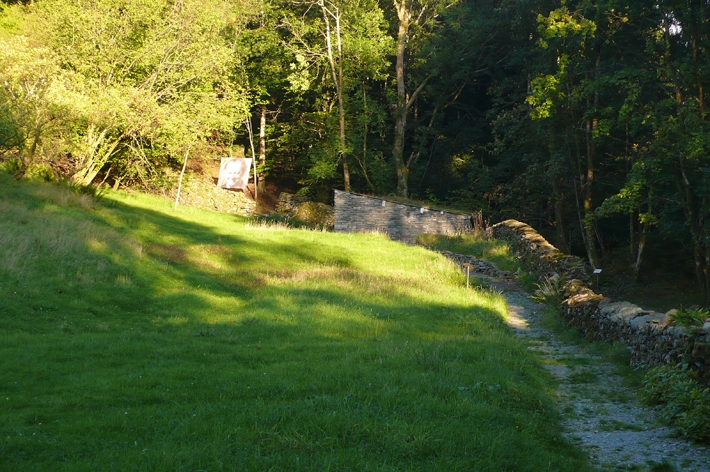
In reflection Hunter is optimistic about the seminar (I suspect his glass is overflowing no matter what happens) and also of course aptly skeptical of any swift transformation. Hunter argues that in recent years ACE has “lost the plot” on their mandate of serving constituencies as required by law. In his view, ACE continues to service the upper class of British tradition, finding ways to delay, stall, and avoid problems instead of confronting the culture that they are responsible for supporting. In Hunter’s mind, ACE has been evasive of recent issues–and like many bureaucracies challenged with change, delays, reviews, and assessments, they’ve stalled action and investment to the detriment of the program and its publics. While Hunter is critical of ACE, he also says that he still admires and supports the core principles and also the originating vision of cultural democracy that contributed to the founding of the Arts Council in the mid-60s, and is very grateful that the public funding it does provide continues to generously support many worthy artistic a cultural projects throughout the country. He acknowledges that when compared with the incredibly modest levels of arts funding provided in the US by the National Endowment for the Arts (NEA), it might appear that artists in England might be complaining unreasonably. The critical difference, he states, is that the UK seems to have have ironically accumulated a hopelessly out of date bureaucratic system that, in some areas of new work at least, seems now seemingly intent on stifling artistic freedom and actively discouraging creative risk taking to its detriment. Hunter admires the NEA for its operational policy, the flexibility with organizations, and a transparency he views as missing from ACE. Hunter says: “Give me the NEA’s grants system and just .1% of US $800 million that the Arts Council England here currently has to give away annually to the (mainly urban) arts here, and I guarantee that we (rural artists) could easily turn around our communities in rural England, and help them achieve their full cultural, artistic, and creative economic potentials.” In many respects, ACE and the NEA share similar challenges, a slow bureaucracy requiring their own advocacy in the wake of large scale government cuts that also necessitates a slow turn-around that favors certain kind of practices and limits access of small-scale spaces to resources. Unlike the NEA’s small annual funds, ACE’s generous three-year allocation can be a blessing and a curse–long term support for organizations that receive funds, and debilitative lack of resources for those left out.
The New Rural Arts Seminar was an opportunity for defining a new emergent practice of rural contemporary art production, in which the Merz Barn is clearly an important leader in the UK movement. From the perspective of a generation of American art organizers who only know the NEA first-hand post-Piss Christ, the ideological and obligatory negotiation between ACE and its constituencies of artists is indeed inspiring. The very fact that ACE attended The New Rural Arts Seminar, that they feel propelled to issue a statement in response to rural issues, and the fact that one national body provides the full funding for its cultures gives these arts funding politics a sense of possibility, urgency, and power largely unfelt in the current US climate of support. The “New Rural,” as an idea and as a moment, has the elements the best organizing movements of any scale are made of — genuine compassion, a capacity to listen, bridge, and synthesize diverse opinions, a diverse mix of generations and ethnicities, a predilection towards action, practical talents and persuasive leaders, an openness to change and service, and a focus on the possible in the here and now. Now, Hunter and his rural compatriots are undergoing an incredibly sensitive political battle that will involve as much contestation against the ACE as it does support, as much public visibility and counteraction as it does handshakes, negotiation, compromise, and shared advocacy.
As it anticipated from the outset, The New Rural Arts Seminar, was simply a start. As a start, it was a very lively one. The political and policy change potential of the seminar remains to be seen. The seminar created a catalyst for bringing together practitioners, and established precedence for future action that might contribute to the rural arts field–whether it be a biennale, summit, or variant therein. The initial formulation of a new rural language might help the next generation of organizers like Vicky Prior and the author of this report carry on the project of dismantling, slowly, the long dynamic of attrition between culture keepers and makers. Indeed, Hunter and Larner’s political work calling the council into question has come at the price of the security of regular council support. But change comes slowly and over time, and its leaders sacrifice personal cost for the dreams of a better world. Those happy stragglers gathered around the evening fire after The New Rural Arts Seminar felt the elated sense, like many artists and organizers around fires before them, that change was possible around the bend. And indeed, as of the publication of this report in April 2015, Hunter and Larner have gotten word that support for a Rural Biennale in 2018 is quite likely on the horizon.
Stephanie Sherman is an art organizer, curator, and writer. She is in the Art Practice Phd program at UCSD. http://stephaniesherman.net.
Notes
[1] MerzBarn / http://www.merzbarn.net/
[2] Littoral Arts Trust: http://www.littoral.org.uk/
[3] Littoral Arts Trust: New Rural Reports / http://www.littoral.org.uk/Resources/New%20Rural%20Arts%20Report.%20%20(WP).pdf; Holden Report / http://www.ruralculture.org.uk/wp-content/uploads/2012/03/ISRfinal_2012.pdf
[4] The arts and rural England: Policy review stage 2 Summary of contributions to the consultation process. Compiled by François Matarasso, February 2005. http://www.artscouncil.org.uk/media/uploads/documents/publications/artsandruralengland_phpMk1oSQ.pdf
[5] Arts Council England Position Report April 2014 / http://www.artscouncil.org.uk/media/uploads/pdf/Position_statement-The_Arts_Council_and_communities_living_in_rural_England_April_14.pdf
[6] The Rural Cultural Forum / http://www.ruralculture.org.uk/projects/biennale/
[7] The League of Culture / http://leagueofculture.org.uk/
[8] The Rural Cultural Forum / www.ruralculture.org.uk
[9] GPS Culture / http://www.gpsculture.co.uk/

